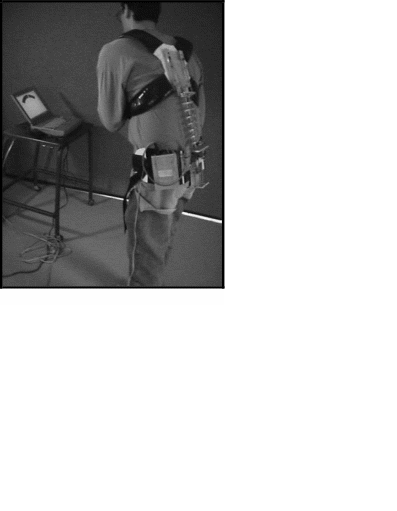Form 7 Low Back Functional Assessment
Musculoskeletal Disorder (MSD) Intervention Effectiveness in an Insurer-Supported Engineering Control Program
Attachment I
Low Back Functional Assessment
OMB: 0920-0907
Form Approved
OMB No. 0920-XXXX
Exp.Date: xx/xx/20xx
Attachment I:
Low Back Functional Assessment
Public reporting burden of this collection of information is estimated to average 20 minutes per response, including the time for reviewing instructions, searching existing data sources, gathering and maintaining the data needed, and completing and reviewing the collection of information. An agency may not conduct or sponsor, and a person is not required to respond to a collection of information unless it displays a currently valid OMB control number. Send comments regarding this burden estimate or any other aspect of this collection of information, including suggestions for reducing this burden to CDC/ATSDR Information Collection Review Office, 1600 Clifton Road NE, MS D-74, Atlanta, Georgia 30333; ATTN: PRA (0920-XXXX).
This assessment will be completed by 20% of participating employees at the start of the study and once every year for 2 years.
The assessment test (conducted by a physical therapist or other professional under direction of a qualified health care practitioner) consists of flexion-extension exertions performed while the trunk is held within one of five asymmetric planes of motion (Figure1). These asymmetric planes of motion consist of: 1) a sagittally symmetric plane (0 degrees of twist), 2) 15 degree twist clockwise (CW) in the transverse plane, 3) 15 degree counterclockwise (CCW) twist, 4) 30 degree CW twist, and 5) a 30 degree CCW twist. The first task is performed in the sagittally symmetric condition followed by the two fifteen degree conditions and finally the two thirty degree conditions. The CW and CCW conditions are counterbalanced at both 15 and 30 degrees. Not all subjects are always able to perform the 15 and 30 degree conditions and this capability serves as an “ability” variable for assessing extent of low back disorder. The lumbar motion monitor described below measures 52 motion measures which represent the trunk’s motion signature. Biomechanically, trunk motion performance is expected to decrease as tasks become more asymmetric because smaller oblique muscles are recruited and necessary for motor control during these tasks. The theory suggests that those with healthy low backs would have a different muscle recruitment pattern since different levels of co-contraction would be expected and reflected in a different motion signature compared to those with LBD. These motion measures are then compared to age and gender specific normal values to distinguish between healthy and impaired performance as well as benchmark the severity of injury. The repeatability and reliability of these measures has been reported previously and found to be excellent (Marras et al, 1999).
Public
reporting burden for this collection of information is estimated to
average 5 minutes per response, including the time for reviewing
instructions, searching existing data sources, gathering and
maintaining the data needed, and completing and reviewing the
collection of information. An agency may not conduct or sponsor,
and a person is not required to respond to a collection of
information unless it displays a currently valid OMB control number.
Send comments regarding this burden estimate or any other aspect of
this collection of information, including suggestions for reducing
the burden estimate to CDC/ASTDR Reports Clearance Officer, 1600
Clifton Road, NE, MS D-74, Atlanta, Georgia 30333; ATTN: PRA
(0920-xxxx)
Apparatus The lumbar motion monitor (LMM) is used to measure trunk motion performance in all three planes of the body. The LMM is an exoskeleton of the spine which is attached to the hips and shoulder using harnesses made of orthoplast (Figure A7-1). These harnesses serve as a stable attachment or “anchoring” point for the LMM in describing the motion of the spine. Since the harnesses embody the thorax and pelvis they permit the LMM to bend between these two attachment points and follow the motion of the thoracolumbar spine. Thus, the LMM measures the change in trunk position of the thoracolumbar spine relative to the hips. The LMM signal is collected at 60Hz and transmitted either by hardwire or telemetry to an analog-to-digital converter on a portable computer. The data is stored for further analysis. The LMM has been validated quantifying position, velocity, and acceleration in all three planes of the body ( Marras et al, 1999).
The task requires the subject to maintain the twisting position (during the flexion and extension exertion) within a tolerance of +/- two degrees from the desired plane of motion (task asymmetry). In order to provide feedback to the participant so they can maintain the trunk motion in the desired plane of motion for each condition, the transverse plane position signal from the LMM is fed to a comparator circuit and displayed on an oscilloscope. This provides both a visual and auditory system of feedback to the participant in order to control the twisting position during the experimental task.
Subject instructions: Subjects are asked to: 1) cross your arms in front of you; 2) stand with your feet shoulder width apart and maintain the same position throughout all the testing conditions; 3) flex and extend your trunk as fast as you can comfortably while maintaining your twisting position within the control zone on the display; 4) watch the display at all times during the tasks; 5) if the twisting position goes outside the control zone, the comparator circuit will sound and the trial will be repeated; and 6) data will be collected for 14 seconds; and 7) move continuously until instructed to “relax”.
Figure M-1
Lumbar Motion Monitor

| File Type | application/vnd.openxmlformats-officedocument.wordprocessingml.document |
| Author | srw3 |
| File Modified | 0000-00-00 |
| File Created | 2021-01-26 |
© 2026 OMB.report | Privacy Policy